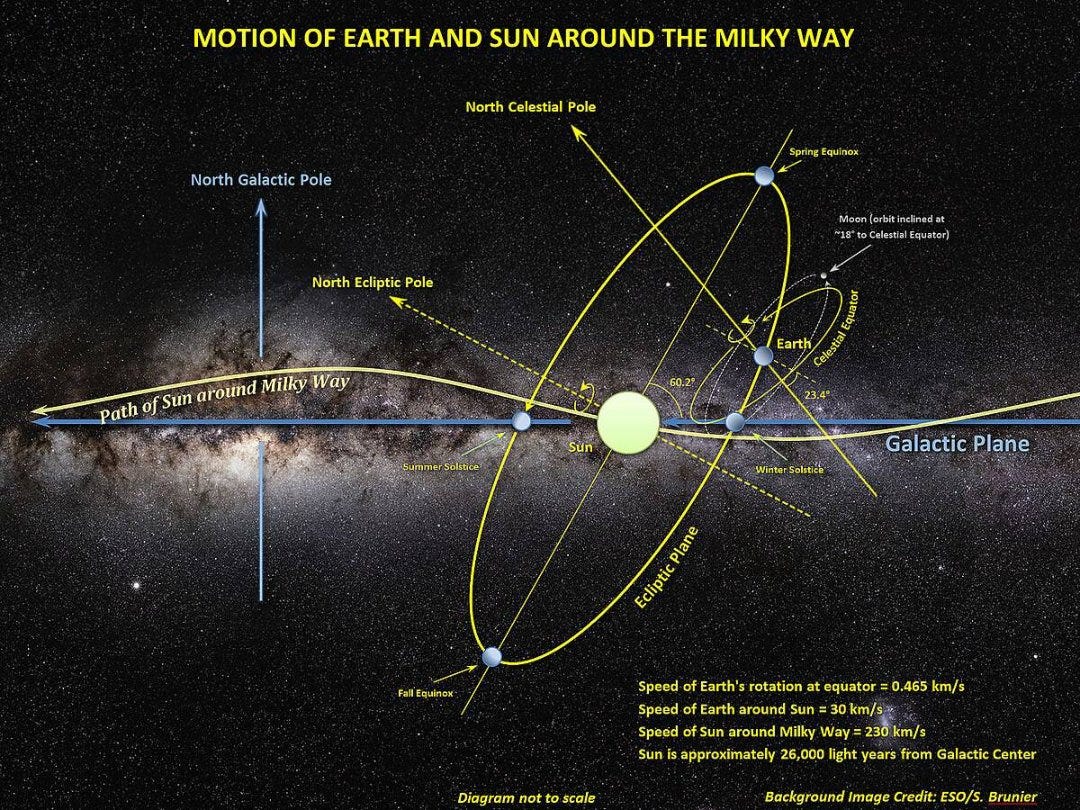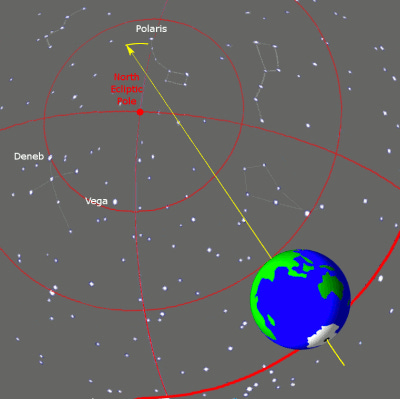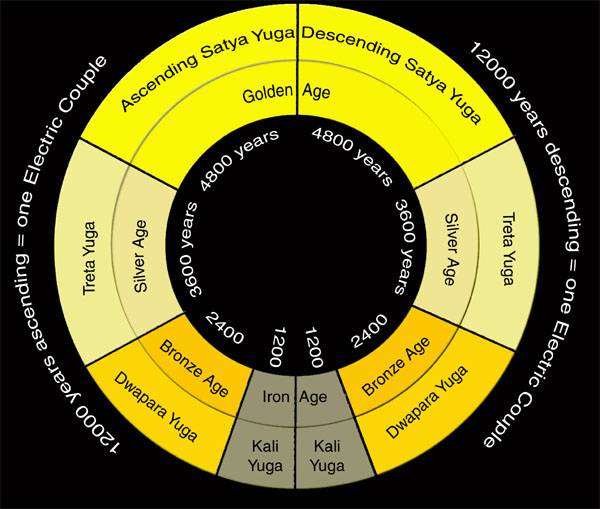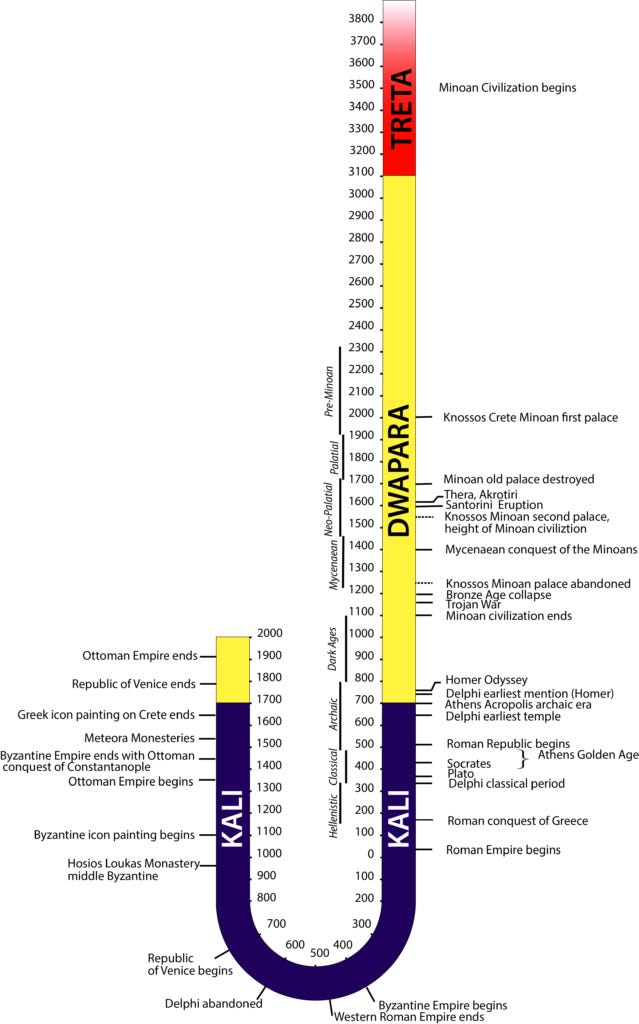The YUGAS and our Universe
21st of March was widely touted as an auspicious Day for the commencement of a GREAT SHIFT in Human Consciousness.
This is tied into the ancient Hindu Cosmology of the Yuga Cycles, with an assumed duration of anywhere between 12,000 and 4,320,000 years.
Taking the vast cosmological timescales involved, pinning any cosmological event to a certain date in our Human Calendar is not exactly meaningful.
These Cycles are, most likely, erroneously based on the oscillation of our Solar System bobbing up and down in Sinusoidal Waves while travelling around the Galactic Centre.
The basis of that Theory is that when our Solar System, and thus Earth along with it, is markedly above the Centre of the Galactic Plane, it receives higher intensity of emanations from the Galactic Centre, whatever these Emanations may be comprised of; i.e.:
► Frequencies of whatever Wavelength
► Particle Winds
► Dark Energy
► or other Unkown Unkonwns!
These are assumed to influence Human Consciousness and thus engender these Cycles where Human Civilizations rise and fall in all aspects in reaction;
Technological, spiritual, emotional, physical, mental disposition, etc!
These Sinusoidal Cycles of our Solar System however take some 60 - 66,000 Million years to complete one full cycle according to all astronomical sources.
Though the 'Precession of the Equinoxes' align more closely with the assumed duration of the Yuga Cycles according to Sri Swami Yukteswar**, namely 24 - 26k years!
This Cycle Duration is now much more widely referenced than the ancient Hindu Timescales of much longer durations.
However how this Precession of the Equinoxes is supposed to influence Human Consciousness, or Earth per se, is unclear, since Earth itself is not changing position relative to the Galaxy, but only wobbles around its own axis.
There are 4 Epochs designated as Yugas:
► Satya Yuga
► Treta Yuga
► Dvapara Yuga
► Kali Yuga
According to these Yuga Cycles, we are presently moving from the Kali Yuga into the Dvapara Yuga.
♦ Yuga Cycle Durations:
❶ The durations of the Yugas according to the revered Indian Guru Sri Swami Yukteswar** are as follows:
► Satya Yuga (Krita) (Golden Age): 4,800 years
► Treta Yuga (Silver Age): 3,600 years
► Dvapara Yuga (Bronze Age): 2,400 years
► Kali Yuga (Iron Age): 1,200 years
Total Duration: 12,000 Years. [i.e. one half of the Sinusoidal Cycle; see Slide 1]
This cycle is divided into an ascending arc (when consciousness and virtue rise) and a descending arc (when consciousness and virtue decline), making the full cycle 24,000 years in total.
Sri Yukteswar also posits that humanity is currently in the ascending phase of the cycle, transitioning from Kali Yuga to Dwapara Yuga, which he believed began around 1699 CE.
This interpretation contrasts with the traditional Hindu view, which assigns much longer durations to the Yugas.
His model emphasizes a more accessible and shorter timescale for spiritual and societal evolution.
❷ The durations according to traditional Hindu Cosmology as written in the ancient Texts:
► Satya Yuga (Golden Age): 1,728,000 years (4,800 divine years)
► Treta Yuga (Silver Age): 1,296,000 years (3,600 divine years)
► Dwapara Yuga (Bronze Age): 864,000 years (2,400 divine years)
► Kali Yuga (Iron Age): 432,000 years (1,200 divine years)
Total Duration: 4,320,000 Years [i.e. one half of the Sinusoidal Cycle]
♦ Characteristics of the Yugas:
► Satya Yuga (or Krita Yuga):
Characteristics:
Known as the "Golden Age," it is the era of truth and righteousness. Humanity is at its peak of spiritual and moral development. People are virtuous, wise, and live in harmony with nature. There is no need for governance or laws, as everyone naturally adheres to dharma (righteousness). The average human lifespan is very long, and suffering is minimal.
► Treta Yuga:
Characteristics:
The "Silver Age" marks the beginning of a decline in virtue and spirituality. Sacrifices and rituals become important, and the concept of governance emerges. People are still largely righteous, but there is a slight decline in moral standards.
The average lifespan decreases compared to Satya Yuga, and the first signs of conflict and inequality appear.
► Dvapara Yuga:
Characteristics:
The "Bronze Age" sees a further decline in righteousness and an increase in vice. People become more materialistic, and the focus shifts from spirituality to worldly pursuits. Knowledge and wisdom begin to diminish, and societal divisions become more pronounced. The average lifespan continues to decrease, and natural disasters and diseases become more common.
► Kali Yuga:
Characteristics:
The "Iron Age" is the current era, marked by a significant decline in morality, spirituality, and wisdom.
Greed, corruption, and ignorance prevail, and people are driven by selfish desires.
Dharma is at its weakest, and suffering, conflict, and inequality are widespread.
The average human lifespan is the shortest among the four Yugas, and the world is plagued by natural disasters, wars, and diseases.
Despite these challenges, it is believed that spiritual liberation is still possible through devotion and righteous living.
♦ Ancient Hindu Sources for the Yuga Cycles:
✘ The Vedas:
While the Vedas themselves do not explicitly detail the Yuga cycles, they contain the foundational concepts of time and cosmology that later texts elaborate upon.
✘ The Puranas:
The Puranas are a genre of ancient Indian texts that provide detailed descriptions of the Yuga cycles. Some of the most important Puranas that discuss the Yugas include:
►► Vishnu Purana:
This text provides a comprehensive account of the four Yugas, their durations, and the characteristics of each age.
►► Bhagavata Purana (Srimad Bhagavatam):
This text also describes the Yuga cycles and the decline in dharma (righteousness) as one moves from Satya Yuga to Kali Yuga.
►► Matsya Purana:
This Purana discusses the Yuga cycles and the avatars of Vishnu that appear in each Yuga.
►► Linga Purana:
This text provides details about the Yugas and the changes in human behavior and spirituality across the ages.
✘ The Mahabharata:
The epic Mahabharata, particularly in the Moksha Dharma Parva of the Shanti Parva, contains discussions on the Yuga cycles and the characteristics of each Yuga.
✘ Manusmriti (Laws of Manu):
This ancient legal text also mentions the Yuga cycles and the decline in moral and ethical standards as one progresses from Satya Yuga to Kali Yuga.
✘ The Upanishads:
Some Upanishads, such as the Maitri Upanishad, briefly touch upon the concept of cyclical time and the ages of the world.
✘ The Bhagavad Gita:
While the Bhagavad Gita does not explicitly detail the Yuga cycles, it does mention the concept of time and the cyclical nature of creation and destruction, which is related to the Yuga theory.
♦ Structure of the Galactic Plane:
Thin Disk:
► This is the region where most of the Milky Way's stars, gas, and dust are concentrated.
It is about 300–400 light-years thick near the Sun but can extend up to 1,000 light-years in other regions.
This layer contains young stars, star-forming regions, and the majority of the interstellar medium (gas and dust).
► Thick Disk:
Surrounding the thin disk is a thicker layer of older stars and fewer gas and dust clouds.
The thick disk is about 2,000–3,000 light-years thick.
It contains older stars that are typically more metal-poor than those in the thin disk.
► Halo:
Beyond the thick disk lies the galactic halo, which is a spheroidal region containing very old stars, globular clusters, and dark matter.
The halo extends much farther, up to 100,000 light-years or more from the galactic center, but it is not considered part of the galactic plane.
► Variations in Thickness:
The thickness of the galactic plane is not constant. In the central bulge of the Milky Way, the disk is much thicker, reaching up to 3,000–4,000 light-years.
In the outer regions of the galaxy, the disk becomes thinner, sometimes as little as 500 light-years.











